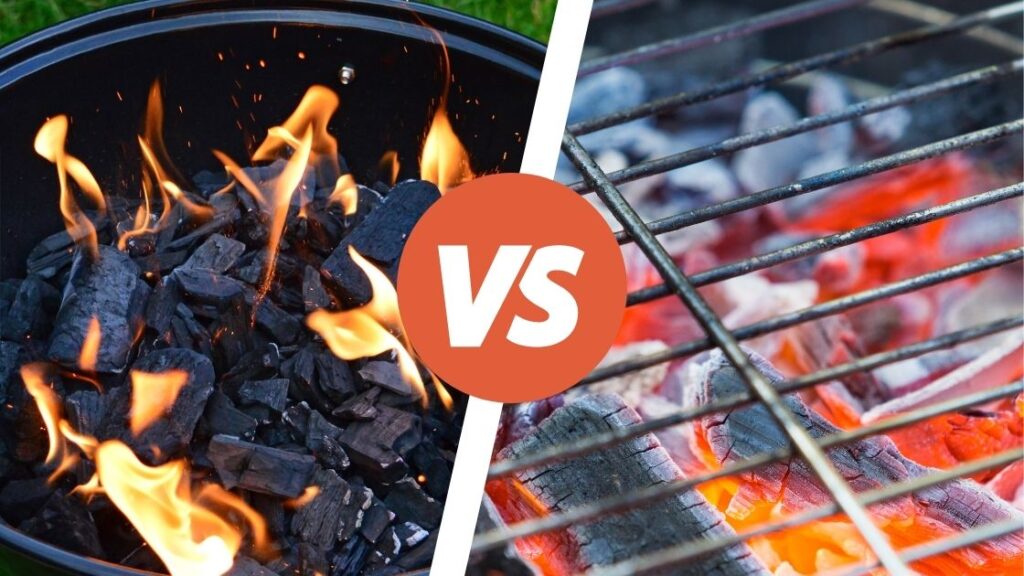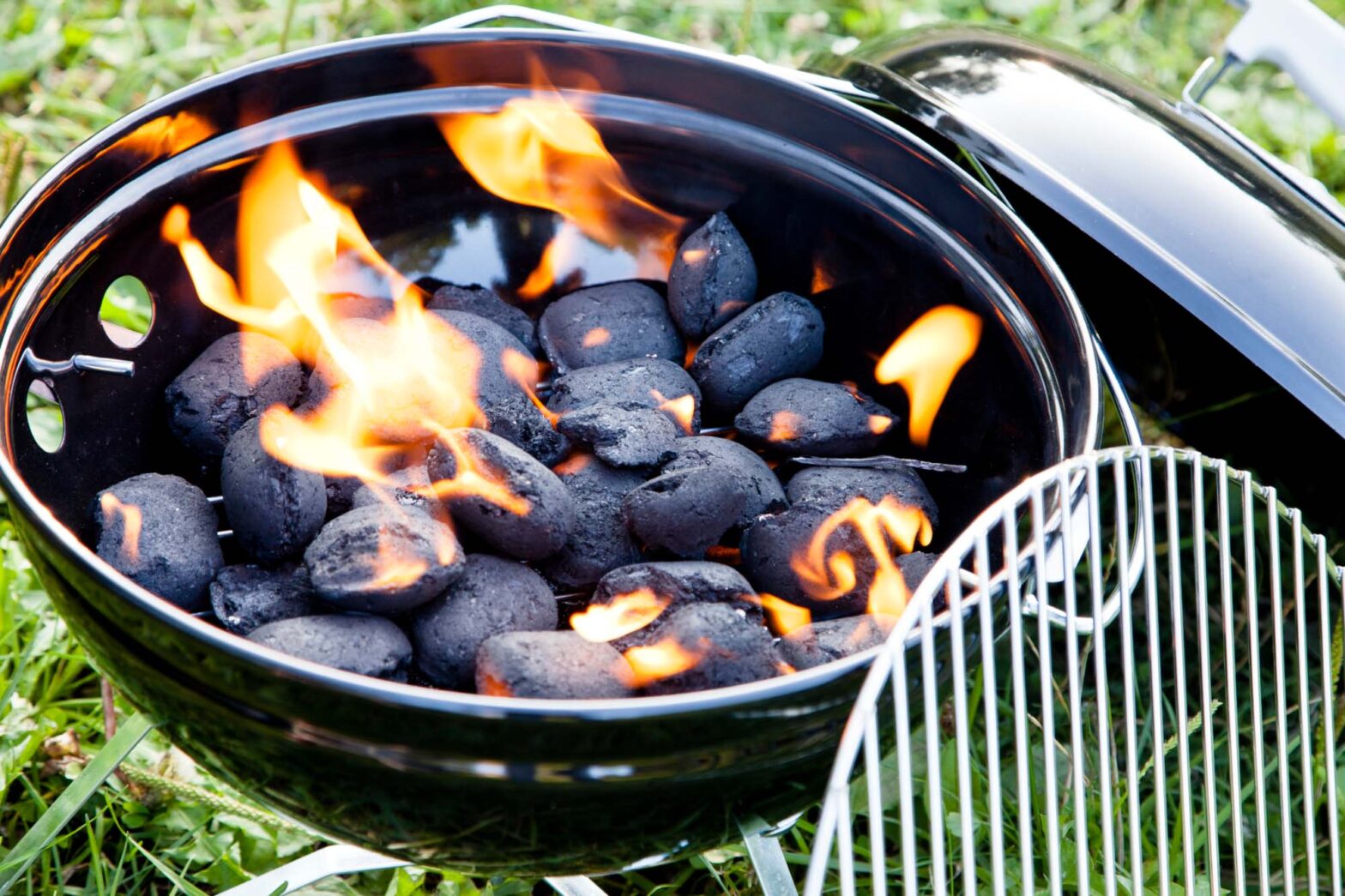Many beginners have questions when it comes to grilling on charcoal. And it’s no wonder: for a raised pit with a lid and vent holes on the top and bottom, a charcoal grill can be surprisingly difficult to master.
When it comes to charcoal grilling, one of the most common questions we get is about the color of the coals. Some wonder, “Can I grill with black coals?” Others ask, “Am I supposed to wait till the coals turn white and ashy?”
In this article, we will break it down for you and help you figure out what color the charcoal in your kettle should be when you’re slapping steaks and slamming sausages on the grate.
Take a gander below to find out.
Can You Grill with Black Coals?
Technically, yes. But it isn’t the ideal way to grill over charcoal. When you’re cooking on black coals, you’re using charcoal that isn’t fully heated yet.
As the black coals continue to heat up, your grill will undergo sudden and significant temperature changes, even if you’ve raked the coals evenly and all over the pit.
Black coals give off thick, heavy smoke that imparts your food with what many a eater say is overly strong flavor. And the flames come up a lot, kissing the meat with excessive heat and burning it up on the outside.
It’s always best to allow time for your charcoal chimney to heat your coals properly or, if you’re not using one, to just wait for your coals to heat up fully.
When Is Charcoal Ready to Grill On?
So far, so good. We’ve established that, contrary to what some grillers think, grilling over charcoal isn’t ideal. (As a matter of fact, it can be counterproductive.)
Then how can you tell when your coals are ready?

Some think that if coal is white and ashy on the outside, it’s fully heated. This isn’t necessarily true. Black coal can appear white on the surface while its exterior remains cool.
The best way to ensure that your coals are hot enough is to wait 15-20 minutes until they are at least ⅔ white and ashen over, and have stopped smoking as much.
Remember that this is just a rule of thumb. On a windy day, you’ll get there a few minutes faster. On a windless day, the charcoal will take a few minutes longer than that to get up to heat.
This applies to the first batch of charcoal and, if you cook for a long time and with several batches of charcoal, to all subsequent batches.
If you’re replenishing the coals after 30-40 minutes of cooking and you’re throwing black coals into the pit, you need to pause the grilling and wait 15-20 minutes to resume it.
If you’re using a chimney starter (more on that below), you can light the subsequent batch of coals beforehand and give them the time to ashen over as you’re grilling on the current batch; the chimney starter is as handy of a grilling tool as they get.
Common Mistakes When Grilling with Black Coals
Here are a few common mistakes people make when grilling with black coals.
Not Using a Chimney Starter
If you’re not using a chimney starter, you should definitely invest in one. Getting the coals ready to grill makes up the toughest part of the grilling process. Most people are tempted to use lighter fluid, thinking this is an easy shortcut.
But when they use chemical agents to increase the heat of their grill, they are also inviting those same chemicals to become a part of their food’s flavor.
Chimney starters allow you to light coals faster and easier. The first thing you do is pack the bottom of the device with newspaper while filling the upper section with black coal.
Then, you just light the bottom, sit back, and let your chimney starter do its thing.
Depending on how much charcoal you’re trying to light, you want to give it 15 and 20 minutes before pouring the heated coals into your grill.
You’ll also need a fireproof place to put your chimney after use. Some folks like to use a cast-iron pot or another fireproof structure or location. You certainly never want to just set it on grass or near anything flammable.
Pouring Coals Into the Kettle Before They’re Done Heating
As we mentioned above, pouring black coals into a grill is not a good idea.
While they may seem hot, they are just warming up and will dramatically impact how your food is cooked. Wait for mostly white or grey coals that don’t smoke, and you’re good to go!
Coals should always, without compromise, be given at least a quarter of an hour to heat up and ashen over.
Creating Only One Cooking Zone Instead of at Least Two
With many gas grill models, you can alter the temperatures of different grill sections with just the twist of a knob. However, you have to do this manually with black coal by raking roughly 75% of the coal over to one side.
This will create two temperature zones along you to cook different foods—either slowly over indirect heat or quickly over direct heat.
Not Preheating the Grill Before Cooking
Black coal grills operate a lot like ovens. You need to preheat them before tossing your food onto the grates (also, it’s a good idea to clean said greatest beforehand).
Once your hot coals are properly distributed inside your grill, throw the lid on and allow it to sit between five and ten minutes before you put your food on. You want to hear a nice sizzle when you set your fruit, protein, or veggies on the grates.
Forgetting to Use the Grill Vents
While it may seem like black coal grills don’t have much control over temperatures as gas grills, it’s actually possible to somewhat control their temperature by using the grill vents on the top and bottom.
These vents are usually located on the grill lid and at the very bottom of the grill base. They control airflow inside the grill, allowing you to crack up the heat substantially by opening the vents.
However, you have to be careful when you do this because it’s super easy to burn food when cooking at higher temperatures.
Common Questions About Grilling with Black Coals
Here are the answers to a few questions people often have concerning grilling with black coals.
How long will black coals stay hot?
Coals that are fully lit will stay hot while you cook for between 30 to 40 minutes without the need for additional hot coals. Now, certain types of charcoal briquettes can burn for about an hour at a steady temperature.
Can you smoke your food with smoldering wood while cooking it over charcoal?
You absolutely can wood smoke your favorite foods using a charcoal grill. You would set your wood chips in foil inside your grill’s indirect or (cool) section. That way, your wood will deliver a smoky flavor while your charcoal provides the heat.
Just keep in mind that there’s a difference between smoking your food—which means cooking large cuts of meat low and slow, for hours on end in a smoker—and imparting grilled food with the flavor of wood smoke by throwing a few foiled chips in the fire.
Should I grill with the lid open or closed?
While hardcore grillers would scream “closed!” the truth is that it depends. Now, most people assume that opening the lid would reduce temperatures the same way on gas grills.
In truth, it’s the exact opposite.
Cooking without a lid actually makes the coals burn hotter as they react to more oxygen. For example, if you normally cook sausages on a gas grill with the lid open to reduce the overall temperature, you will want to keep the lid closed on a coal grill while keeping your sausage on the indirect heat or “cool” side.
When should I open and close the vents during grilling?
This is one thing that really confuses people new to black coal grilling. You always have to be mindful of your vents.
Even if you cook with your lid off, you’ll still need to mind your bottom vent because if it’s open, the coals still burn even hotter. Your vents can help you cook foods using indirect heat more efficiently.
It takes practice to master using vents, and you can use a handy surface grill placed directly on the grates to check surface temperatures to make things just right.
The Bottom Line
As you’ve learned, grilling with black coals is possible, but you never want to do it. The coals need to be nearly all-white or gray and smokeless before they are ready to cook. Otherwise, you will have wildly uncontrollable temperatures.
We hope this handy guide has helped you become a more confident griller. With practice, you’ll master the black coal grill in no time!

